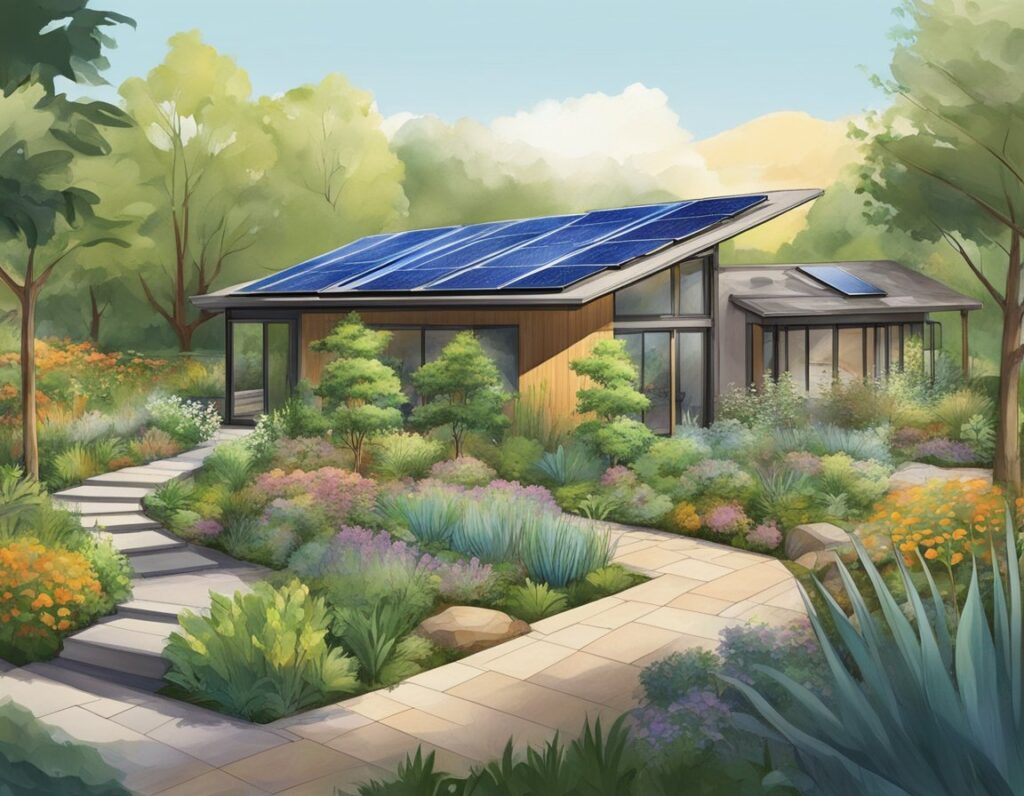Sustainable landscape and roofing design is more than just a trend; it’s a fundamental shift in how we visualise and create spaces that connect us to the natural world. It’s an acknowledgement that you, as a stakeholder in the environment, have the power to shape ecosystems through informed design choices.
Landscape sustainability focuses on preserving local ecology, conserving resources, and designing spaces that are both aesthetically pleasing and functional for your needs.
By working with nature rather than against it, you can cultivate a landscape that not only thrives but also supports biodiversity and the broader environmental goals.

The visualisation of sustainable landscapes is an essential step in the design process. It allows you to see the potential of a space, understanding how each element works together to form a cohesive whole.
Whether you’re looking to create a private oasis, a public park or a corporate green space, the principles of sustainability can be applied.
Embracing these principles involves water conservation, soil health, and sustainable material selection for your project.
Tools and techniques such as computer-aided design (CAD), modelling, and virtual reality can bring these sustainable concepts to life, empowering you to make informed decisions about your impact on the environment.
Key Takeaways
- Sustainable landscape design intertwines ecological well-being with aesthetic and functional aspects.
- Understanding and applying sustainability principles is crucial in creating spaces that are both efficient and harmonious with nature.
- Visualisation tools aid in realising the potential and impact of sustainable design choices before they materialise.
Fundamentals of Sustainable Landscape Design
When envisioning your outdoor space, sustainable landscape design plays a pivotal role in creating an environment that is both aesthetically pleasing and ecologically responsible.
Principles of Sustainability
You’ll find that the core principles of sustainability in landscape design focus on three primary aspects: environmental, economic, and social. These principles aim to reduce the environmental impact while maintaining the cost-effectiveness and enhancing the quality of life for individuals using the space.
To apply these principles:
- Environmental: Choose native plants that require less water and are resilient to local pests.
- Economic: Invest in durable materials that are sustainably sourced to reduce long-term maintenance costs.
- Social: Design spaces that promote community interaction and well-being, such as community gardens.
Ecological Considerations
Your landscape should exist in harmony with local ecosystems. Take into account the following:
- Biodiversity: Maintain a variety of species to support a resilient ecosystem.
- Soil Health: Use compost and avoid chemicals to preserve soil quality.
- Local Wildlife: Incorporate elements like birdhouses or pollinator gardens that support native fauna.
Designing with Water Efficiency
Water is a precious resource, particularly in the UK where water stress can be a concern.
To design with water efficiency:
- Rainwater Harvesting: Install systems to collect and use rainwater for irrigation.
- Drip Irrigation: Embrace drip irrigation systems to deliver water directly to the roots with minimal waste.
- Plant Selection: Opt for drought-resistant plants that thrive with less water and create a list of such plants tailored to your region.
| Drought-Resistant Plants | Water Needs |
|---|---|
| Lavender (Lavandula) | Low |
| Rosemary (Rosmarinus officinalis) | Low |
| Russian Sage (Perovskia) | Low |
Visualisation Techniques and Tools
Landscape design in the UK benefits greatly from advanced visualisation techniques and tools, allowing you to effectively communicate and explore sustainable designs.
Digital Rendering and Modelling
You have access to a variety of digital rendering and modelling tools to bring landscape designs to life.
Software like AutoCAD and SketchUp facilitates the creation of detailed 3D models of landscapes, showing how they change through seasons or over the years.
With Geographic Information Systems (GIS), you can integrate data layers to visualise terrain, waterways, vegetation, and wildlife habitats.
These insights are crucial for designing landscapes with sustainability in mind.
Innovative Presentation Methods
To convey your sustainable landscape designs, leverage innovative presentation methods.
Use of mixed reality (MR) and virtual reality (VR) allows stakeholders to immerse themselves into proposed designs before any physical changes are made.
Infographics and interactive maps are other powerful tools for illustrating complex ecological data in a more digestible format.
Community Engagement Through Visualisation
Community engagement is enhanced with visualisation.
Participatory GIS (PGIS) and Public Participation GIS (PPGIS) are platforms that encourage community involvement in the design process.
They allow you to collect and map local knowledge and preferences. This ensures the landscape meets the needs and values of the people it serves.
This collaborative approach not only empowers communities, but also ensures long-term viability and support for sustainable landscape initiatives.